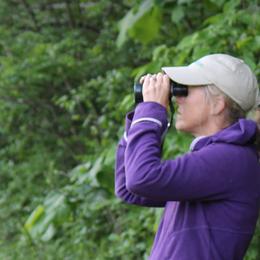For many of us, getting outdoors and on the trails this spring has been a huge relief from the stress of this unprecedented time. Unfortunately, the increase in use of some of our recreation areas may be having an impact on the sensitive Peregrine Falcon. Peregrines nest on cliffs throughout Vermont, and the majority of these areas are popular for recreation, including hiking, climbing, or just enjoying a view. Several of these areas have been closed to minimize disturbance from hikers and/or rock climbers during the time of year when the birds are most sensitive, as well as to protect hikers and climbers from being dive-bombed by these raptors who are fiercely protective of their nests.
Peregrines begin their breeding season in late winter, and are usually incubating eggs by late March or early April. It takes about a month for the eggs to hatch and approximately 6 weeks for the young to develop before they learn to fly. Peregrines are most likely to be disturbed by people standing above their nesting site or climbing near it. Biologists from Audubon Vermont and Vermont Fish and Wildlife Department work with landowners and managers each spring to determine which areas are appropriate to close and which can remain open. Thanks to an enormous effort from landowners and partners such as CRAG-VT, Green Mountain Club, Green Mountain National Forest, Vermont Forests, Parks & Recreation, and others, people can learn about these closures before they go to the sites and can therefore plan alternate routes and/or places to visit.
Climbers who are part of the CRAG-VT network have been essential to the overall success of Peregrine Falcons in Vermont. They have been instrumental in alerting biologists about new peregrine pairs, helping to specify closure areas, and providing additional useful information that ensures a peregrine pair’s success.
Audubon Vermont and Vermont Fish & Wildlife staff and community scientists monitor peregrine nesting sites from a distance from April through July and document each pair’s productivity.
This season volunteers have been observing more human traffic than usual, both near and above the nest sites. And, unfortunately there have been several sites that appear to have been abandoned early in the season.
It’s hard to pinpoint exactly why a site may be abandoned, as there are a number of factors that could cause this to happen: predation of eggs or chicks, injury or death of one of the pair, and/or human disturbance. Other factors that may cause a nest to fail but are unlikely to cause a site to be abandoned are extreme weather and/or inexperience of one of the members of the pair. Seeing so much activity at some of the nesting cliffs this spring indicates that human disturbance has been a factor at one or more sites.
While it’s important for all of us to be outdoors, it is also important to respect the physical distancing our wildlife needs to be successful. Peregrines have made a remarkable comeback in Vermont, and their continued success has been in large part because people respect their need for space during the breeding season. It is our responsibility to ensure that their success is sustained.
For more information on current closures, please see: https://vtfishandwildlife.com/node/212
For more information on Peregrine Falcons and their recovery in Vermont, visit: https://vt.audubon.org/conservation/peregrine-falcon-recovery-project





